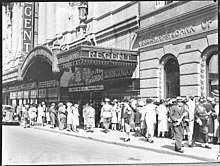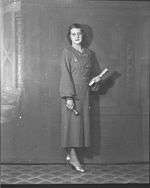Regent Theatre (Sydney)
The Regent Theatre was a heritage-listed cinema and entertainment venue in Sydney, New South Wales, Australia, which was demolished in 1988 by property developer Leon Fink.
 | |
%26groups%3D_2fae232907efba6fbf288fbafffc2462c22fcb12.svg)
| |
| Address | 487-503 George Street Sydney, NSW Australia |
|---|---|
| Coordinates | 33°52′29″S 151°12′23″E |
| Owner | Hoyts |
| Capacity | 2258 |
| Construction | |
| Opened | 9 March 1928 |
| Closed | 26 May 1984 |
| Demolished | 1988 |
| Architect | Cedric Ballantyne |

Description and history
The Regent Theatre was Hoyts' showcase "picture palace" in Sydney, designed by the distinguished architect Cedric Ballantyne and built by James Porter & Sons.[1]
The 2000 seat theatre[2] was located at 487-503 George Street, Sydney, near the Sydney Town Hall. It stood next door to the famed Sydney Trocadero dance hall, which was demolished in 1971.
The Regent operated as a cinema for most of its life, including the premiere Sydney season of Ken Russell's film version of Tommy in 1975 (presented in "Quintaphonic" sound), but from the mid-1970s to the mid-1980s it was also a popular venue for music concerts and stage shows, and in its final years hosted many large-scale musicals and performances by the Australian Opera and Australian Ballet and other theatrical and musical performances, including Marcel Marceau, Debbie Reynolds, Barry Humphries, the musical Barnum, Liza Minnelli, The Dance Theatre of Harlem, Tangerine Dream, and "The Two Ronnies" (Ronnie Barker & Ronnie Corbett),[3] The gala opening was on 9 March 1928 with the film Flesh and the Devil starring John Gilbert and Greta Garbo, and the theatre closed with a screening of the documentary Ski Time on 26 May 1984. The last live performance was by American musician Ellen McIlwaine on 19 May 1984.
In 1974, the trade union Actor's Equity asked the Builders Labourers Federation to place a green ban to prevent demolition of the theatre.[4]
In the late 1970s many meetings of the Australian Broadcasting Commission Staff Association were held there at very reasonable rates, the owner being sympathetic to the trade union.[5]
Demolition commenced in late 1988 after a court decision upheld the lifting of the permanent conservation order by the Minister for Planning and Local Government, David Hay.
The slump in the Sydney property market that followed meant that the site remained a vast hole in the ground until 2004, when work finally began on a new high-rise building complex.
Many of the theatre's fittings were sold at an auction in 1990, and can be found in a number of locations around Sydney and NSW. A lightweight plastic replica of the Art Deco crystal chandelier from the Regent's foyer now hangs in the foyer of the nearby The Metro Theatre; redeveloped from a cinema, it is now the city's leading rock music venue. The fate of the original chandelier, from which the Metro's copy was made, is unknown.
The theatre had been listed on the Register of the National Estate,[6] but this did not prevent its demolition by property magnate Leon Fink.
The remodelled Regent Melbourne which has been converted for live performance still exists, as does the Regent Theatre, Dunedin in New Zealand, which serves as both a live performance venue and a cinema.
References
- The Heritage of Australia, Macmillan Company, 1981, p.2/101
- Daily Mirror 14/04/1988
- Ausstage - Regent Theatre
- "List of green bans, 1971-1974". libcom.org. Retrieved 16 October 2019.
- Molomby, Tom, Is there a moderate on the roof? ABC Years, William Heinemann Australia, Port Melbourne, 1991, p.96
- The Heritage of Australia, p.2/101